Comments / Questions (27)
![]() Marit Tvervåg wrote:
Marit Tvervåg wrote:
Kan dette mønsteret strikkes rundt opp til armene?
18.02.2023 - 13:56DROPS Design answered:
Hej Marit, mønsteret er forklaret for at strikke frem og tilbage... hvis du vælger at strikket rundt, så skal hver 2.pind strikkes vrang fra retsiden :)
23.02.2023 - 15:05
![]() Carina Swanström wrote:
Carina Swanström wrote:
Hej, har kommit fram till att det inte stämmer när det gäller maskantalet på ärmarna på mönster ab-043. Spelar ingen roll vilka stickor jag använder. Har prövat rundsticka 7 80cm och rundsticka 7 40cm. Även prövat med vanliga raka men ärmen blir alldeles för stor runt handled. Om jag skulle minska antalet maskor så kommer den ju inte att passa vid axeln. Så hur skall jag göra? Tacksam för svar. MVH// Carina
01.09.2019 - 16:45DROPS Design answered:
Hei Carina. Om du syns den blir for vidd rundt håndleddet, kan du f.eks legg opp mindre masker, og da øke disse maskene når det skal økes frem til ferdig mål (øke oftere). Bare husk å ha samme maskeantall ved slutt som det står i oppskriften. God Fornøyelse!
02.09.2019 - 11:49
![]() Ingeborg Mortensen wrote:
Ingeborg Mortensen wrote:
Har lavet strikkeprøve. Men når jeg strikker mønsteret bliver arbejdet ca 30 cm for bred. Øv. Har pillet op ,hvad nu?
12.07.2017 - 11:42DROPS Design answered:
Hej Ingeborg, hvis du har 14 m på 10 cm i bredden, så stemmer målene med dem som står i måleskitsen. Husk at hulmønsteret gør tøjet elastisk, det vil sige at jo mere du strikker i højden, jo mere vil det også vokse i højden og samtidig trække sig lidt sammen i bredden. Hvis det bliver for bredt så kan du prøve med et pindenummer mindre. God fornøjelse!
12.07.2017 - 12:02
![]() Helle Petersen wrote:
Helle Petersen wrote:
Lys søgrøn Jeg har købt garn til denne trøje med 50 % rabat i en netshop. Valgte lys søgrøn, lidt efter udelukkelses metoden da jeg ikke havde lyst til at strikke noget i beige eller brund. Hold da op det er en flot farve og rigtigt lækkert at strikke i lige nu hvor det er 27 grader i skyggen på min terasse. Jeg strikker faktisk kun Drops modeller da de findes i str. 3XL, dejligt når man er en fyldig kvinde.
06.06.2016 - 11:53Wendy French wrote:
By mistake I started this sweater on US 7 needles...so it should have been way too small...but it was about three times wider than it should have been for the size I was knitting. Disappointing, frustrating, and a waste of time!
21.02.2016 - 14:10DROPS Design answered:
Dear Mrs French, remember to check and keep correct tension, ie 14 sts x 17 rows in stockinette st = 10 x 10 cm - this jumper has an oversized shape - see measurements for each size in measurement chart. Happy knitting!
22.02.2016 - 11:30Shirley wrote:
I have done three swatches with this pattern using the required wool and gauge. However the number of rows on each one is too long. Using 6.5 mm gives me the nearest width for the gauge but the length is more than the required 10 cm. Do you have any suggestions.
08.11.2015 - 22:48DROPS Design answered:
Dear Shirley, you can try another technique for your K/P sts - see videos under video tab - remember your DROPS store will also have tips & advices for a personnal assistance. Happy knitting!
02.12.2015 - 17:10
![]() Marianne Hansen wrote:
Marianne Hansen wrote:
Har fundet glittergarnet . tak for hjælpen Hilsen Marianne
21.01.2015 - 17:38
![]() Marianne Kjær Hansen wrote:
Marianne Kjær Hansen wrote:
Hej Igen Tak for dit svar jeg har prøvet og søge på Drops glitter , men der kommer ikke noget frem ,kan du hjælpe ? Hilsen Marianne
21.01.2015 - 17:32Barbara McLennan wrote:
I knitted most of this pattern only to fine it looked terrible, really messy and the drop stitches look twice as long as those in the photo. My tension seems right though as the garment measures the same in width as my chosen size. I am considering starting all over, but don't want the same result. The only thing I did differently is knitted the pattern in the round to the armholes. Maybe I am just not good with big needles. Any ideas? Or do I make a scarf :)
05.12.2014 - 01:54DROPS Design answered:
Dear Mrs McLennan, working in the round maybe the reason that it didn't work - you make double yos, so that the drop is longer than normal, but if your tension is correct, it should work. What about make a swatch and wash it (to make the pattern "settle" more). For any individual help, remember you can contact your DROPS store. Happy knitting!
05.12.2014 - 11:33
![]() Gaby Horn wrote:
Gaby Horn wrote:
Ich kann die Anleitung für dieses Modell nicht drucken?
02.12.2014 - 18:24DROPS Design answered:
Wenn Sie auf "Drucken: Anleitung" klicken, erscheint ein neues Fenster mit dem Hinweis auf die Alpaca-Party. Über dem Bild sehen Sie die Schrift "Die Anleitung ausdrucken", wenn Sie darauf klicken, erscheint die Druckversion. Alles weitere müssen Sie dann in den Druckeinstellungen Ihres PCs bzw. Druckers eingeben, aber es sollte eigentlich problemlos funktionieren.
03.12.2014 - 16:06
Sandy#sandysweater |
|
|
|
|
Knitted DROPS jumper in garter st with dropped sts in ”Alpaca Bouclé”. Size: S - XXXL.
DROPS 153-18 |
|
|
GARTER ST (back and forth on needle): K all rows. 1 ridge = K2 rows. GARTER ST (in the round): * K 1 round and P 1 round *, repeat from *-*. 1 ridge = 2 rounds. MEASURING TIP: Because of the pattern all measurements must be done by holding the piece up otherwise the garment will be too long when worn. PATTERN: Row 1-6: K all sts. Row 7: * K 1, 2 YOs *, repeat from *-* until 1 st remains, finish with K 1. Row 8: * K 1, drop YOs off the needle *, repeat from *-* until 1 st remains, finish with K 1. Repeat row 1 to 8 until finished measurements. ---------------------------------------------------------- JUMPER: Worked back and forth on circular needle to make room for all the sts. The entire body is worked in PATTERN - see explanation above. Work sleeves in stockinette st with 6 ridges at the bottom. BACK PIECE: Cast on 72-78-84-90-98-108 sts (includes 1 edge st in each side) on circular needle size 7 mm / US 10.75 with Alpaca Bouclé. Work pattern. REMEMBER THE GAUGE! When piece measures 43-44-45-46-47-48 cm / 17"-17¼"-17¾"-18"-18½"-19" – READ MEAURING TIP – bind off 1 edge st in each side for armhole at beg of the next 2 rows = 70-76-82-88-96-106 sts. Work until piece measures 58-60-62-64-66-68 cm / 22¾"-23⅝"-24⅜"-25¼"-26"-26¾", adjust so that next row is 1st row in pattern. Slip the middle 20-22-24-26-26-28 sts on a stitch holder for neck and finish each shoulder separately. Continue to bind off 1 st on next row from neck = 24-26-28-30-34-38 sts remain on the shoulder. Loosely bind off all sts when piece measures 60-62-64-66-68-70 cm / 23⅝"-24⅜"-25¼"-26"-26¾"-27½". FRONT PIECE: Cast on and work as back piece. When piece measures 50-52-54-56-58-60 cm / 19¾"-20½"-21¼"-22"-22¾"-23⅝", adjust so that next row is 1st row in pattern, slip the middle 20-22-24-26-26-28 sts on a stitch holder for neck and finish each shoulder separately. Continue to bind off 1 st on next row from neck = 24-26-28-30-34-38 sts remain on the shoulder. Loosely bind off all sts when piece measures 60-62-64-66-68-70 cm / 23⅝"-24⅜"-25¼"-26"-26¾"-27½". SLEEVE: Worked back and forth on circular needle. Cast on 38-40-42-44-46-48 sts (includes 1 edge st in each side) on circular needle size 7 mm / US 10.75 with Alpaca Bouclé. Work 6 ridges in garter st. Continue in stockinette st with 1 edge st in garter st in each side. When piece measures 8 cm / 3⅛", inc 1 st in each side. Repeat inc every 6-5-5-4-4-3 cm / 2⅜"-2"-2"-1½"-1½"-1⅛" 5-6-6-7-7-8 more times (= 6-7-7-8-8-9 inc in total) = 50-54-56-60-62-66 sts. When piece measures 44-43-42-41-39-36 cm / 17¼"-17"-16½"-16⅛"-15¼"-14¼" (shorter measurements in the larger sizes because of wider shoulders), bind off all sts. ASSEMBLY: Sew the shoulder seams. Sew in sleeves. Sew underarm seams and side seams in one inside one edge st. NECK EDGE: Pick up around the neck from RS 76 to 94 sts (includes sts on stitch holders) with Alpaca Bouclé on circular needle size 7 mm / US 10.75. Work 2 ridges in garter st. Bind off. |
|
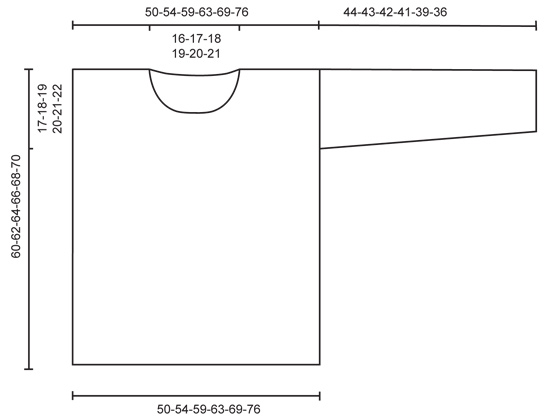 |
|
Have you finished this pattern?Tag your pictures with #dropspattern #sandysweater or submit them to the #dropsfan gallery. Do you need help with this pattern?You'll find 21 tutorial videos, a Comments/Questions area and more by visiting the pattern on garnstudio.com. © 1982-2026 DROPS Design A/S. We reserve all rights. This document, including all its sub-sections, has copyrights. Read more about what you can do with our patterns at the bottom of each pattern on our site. |












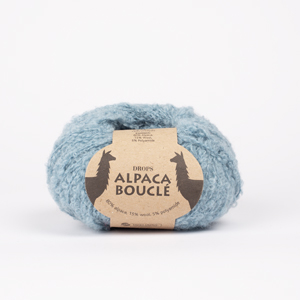
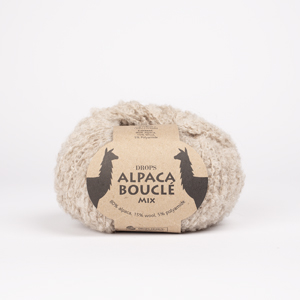





































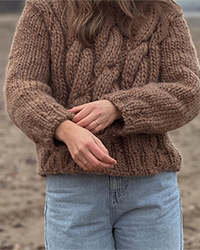

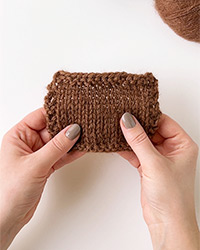
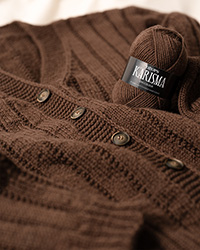
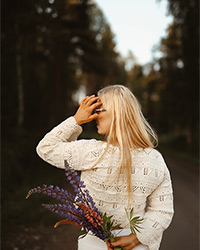

Post a comment to pattern DROPS 153-18
We would love to hear what you have to say about this pattern!
If you want to leave a question, please make sure you select the correct category in the form below, to speed up the answering process. Required fields are marked *.